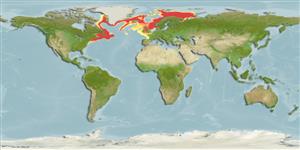| Native range | All suitable habitat | Point map | Year 2100 |

|
| Hippoglossus hippoglossus AquaMaps Data sources: GBIF OBIS |
Length at first maturity
Lm 122.0, range 135 - ? cm
Utilização humana
Pescarias: espécies comerciais; Aquacultura: experimental; peixe desportivo: sim; Aquário: Aquários públicos
Phylogenetic diversity index
(Ref. 82805)
PD50 = 0.7500 many relatives (e.g. carps) 0.5 - 2.0 few relatives (e.g. lungfishes)
Nível Trófico
(Ref. 69278)
4.0 ±0.5 se; Based on diet studies.
Resiliência
(Ref. 69278)
Muito baixo, tempo mínimo de duplicação da população maior que 14 anos (tmax=30; tm=10; K=0.02-0.2; Fec=1,300,000; also Musick et al. 2000 (Ref. 36717))